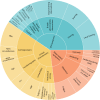Symptom content analysis of OSA questionnaires: time to identify and improve relevance of diversity of OSA symptoms?
- PMID: 38420966
- PMCID: PMC11217627
- DOI: 10.5664/jcsm.11086
Symptom content analysis of OSA questionnaires: time to identify and improve relevance of diversity of OSA symptoms?
Abstract
Study objectives: Obstructive sleep apnea (OSA) is a heterogeneous condition covering many clinical phenotypes in terms of the diversity of symptoms. Patient-based OSA screening questionnaires used in routine practice contain significantly varying contents that can impact the reliability and validity of the screening. We investigated to what extent common patient-based OSA screening questionnaires differ or overlap in their item content by conducting a rigorous, methodical, and quantified content overlap analysis.
Methods: We conducted an item content analysis of 11 OSA screening questionnaires validated in adult populations and characterized their overlap using a 4-step approach: (1) selection of OSA screening questionnaires, (2) item extraction and selection, (3) extraction of symptoms from items, and (4) assessment of content overlap with the Jaccard index (from 0, no overlap, to 1, full overlap).
Results: We extracted 72 items that provided 25 distinct symptoms from 11 selected OSA questionnaires. The overlap between them was weak (mean Jaccard index: 0.224; ranging from 0.138 to 0.329). All questionnaires contained symptoms of the "OSA symptom" dimension (eg, snoring or witnessed apneas). The STOP-BANG (0.329) and the Berlin (0.280) questionnaires exhibited the highest overlap content. Ten symptoms (40%) were investigated in only 1 questionnaire.
Conclusions: The heterogeneity of content and the low overlap across these questionnaires reflect the challenges of screening OSA. The different OSA questionnaires potentially capture varying aspects of the disorder, with the risk of biased results in studies. Suggestions are made for better OSA screening and refinement of clinical OSA phenotypes.
Citation: Gauld C, Baillieul S, Martin VP, et al. Symptom content analysis of OSA questionnaires: time to identify and improve relevance of diversity of OSA symptoms? J Clin Sleep Med. 2024;20(7):1105-1117.
Keywords: content analysis; obstructive sleep apnea; questionnaires; sleep disorders; sleep symptoms; symptom overlap.
© 2024 American Academy of Sleep Medicine.
Conflict of interest statement
All authors have read and agreed to the published version of the manuscript. The authors report no conflicts of interest.
Figures





Similar articles
-
A novel machine learning model for screening the risk of obstructive sleep apnea using craniofacial photography with questionnaires.J Clin Sleep Med. 2025 May 1;21(5):843-854. doi: 10.5664/jcsm.11560. J Clin Sleep Med. 2025. PMID: 39815737
-
Validation of the STOP-Bang Questionnaire as a Screening Tool for Obstructive Sleep Apnea among Different Populations: A Systematic Review and Meta-Analysis.PLoS One. 2015 Dec 14;10(12):e0143697. doi: 10.1371/journal.pone.0143697. eCollection 2015. PLoS One. 2015. PMID: 26658438 Free PMC article.
-
A systematic review of screening questionnaires for obstructive sleep apnea.Can J Anaesth. 2010 May;57(5):423-38. doi: 10.1007/s12630-010-9280-x. Epub 2010 Feb 9. Can J Anaesth. 2010. PMID: 20143278
-
Drug therapy for obstructive sleep apnoea in adults.Cochrane Database Syst Rev. 2006 Apr 19;(2):CD003002. doi: 10.1002/14651858.CD003002.pub2. Cochrane Database Syst Rev. 2006. Update in: Cochrane Database Syst Rev. 2013 May 31;(5):CD003002. doi: 10.1002/14651858.CD003002.pub3. PMID: 16625567 Updated.
-
Prevalence and predictors of obstructive sleep apnea in collegiate football players.J Clin Sleep Med. 2025 Jul 1;21(7):1233-1243. doi: 10.5664/jcsm.11646. J Clin Sleep Med. 2025. PMID: 40135688
Cited by
-
Clinical significance criteria in the ICSD and DSM sleep disorder classifications: a content overlap analysis using the Jaccard index.J Clin Sleep Med. 2025 Jun 1;21(6):1109-1121. doi: 10.5664/jcsm.11570. J Clin Sleep Med. 2025. PMID: 39862150 Review.
-
Oxytocin Receptor Polymorphism Is Associated With Sleep Apnea Symptoms.J Endocr Soc. 2024 Nov 26;9(1):bvae198. doi: 10.1210/jendso/bvae198. eCollection 2024 Nov 26. J Endocr Soc. 2024. PMID: 39606181 Free PMC article.
-
Big data approaches for novel mechanistic insights on sleep and circadian rhythms: a workshop summary.Sleep. 2025 Jun 13;48(6):zsaf035. doi: 10.1093/sleep/zsaf035. Sleep. 2025. PMID: 39945146
-
A proposition of hybrid healthcare pathway to screen and diagnose obstructive sleep apnea: exploratory analysis of retrospective observational data.Sleep Breath. 2025 Jun 11;29(4):212. doi: 10.1007/s11325-025-03381-5. Sleep Breath. 2025. PMID: 40498151
-
Clinical physiology of circadian rhythms: A systematic and hierarchized content analysis of circadian questionnaires.Int J Clin Health Psychol. 2025 Apr-Jun;25(2):100563. doi: 10.1016/j.ijchp.2025.100563. Epub 2025 Apr 4. Int J Clin Health Psychol. 2025. PMID: 40248163 Free PMC article.
References
-
- Lévy P , Kohler M , McNicholas WT , et al . Obstructive sleep apnoea syndrome . Nat Rev Dis Primers. 2015. ; 1 ( 1 ): 15015 . - PubMed
-
- Veasey SC , Rosen IM . Obstructive sleep apnea in adults . N Engl J Med. 2019. ; 380 ( 15 ): 1442 – 1449 . - PubMed
-
- Trzepizur W , Blanchard M , Ganem T , et al . Sleep apnea-specific hypoxic burden, symptom subtypes, and risk of cardiovascular events and all-cause mortality . Am J Respir Crit Care Med. 2022. ; 205 ( 1 ): 108 – 117 . - PubMed
MeSH terms
LinkOut - more resources
Full Text Sources

